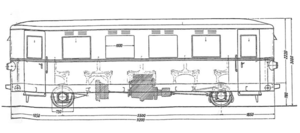NHS T1
| NHS T1 | |
|---|---|
|
Work drawing
|
|
| Numbering: | NHS T1 OFF T02 |
| Number: | 1 |
| Manufacturer: | Waggonfabrik Gotha |
| Year of construction (s): | 1934 |
| Retirement: | after 1980 |
| Axis formula : | A1 |
| Genre : | CvT |
| Gauge : | 1435 mm ( standard gauge ) |
| Length over buffers: | urpr. no information, after conversion 11,000 mm |
| Length: | 9,200 mm |
| Height: | 3,000 mm |
| Total wheelbase: | 5,500 mm |
| Service mass: | originally 7,500 kg, after reconstruction 15,300 kg |
| Top speed: | 60 km / h |
| Installed capacity: | originally 48 kW (65 PS), after conversion 125 kW (170 PS) |
| Wheel diameter: | 730 mm, no information after conversion |
| Motor type: | Originally four-cylinder four-stroke diesel engine, no information after conversion |
| Motor type: | originally Daimler-Benz OM 65, no details after conversion |
| Rated speed: | 2,000 rpm |
| Power transmission: | mechanical with Mylius gearbox , no information after conversion |
| Seats: | 42 |
| Standing room: | 28 |
| Floor height: | 780 mm |
| Classes : | 3rd, from 1956: 2nd |
The two-axle railcar NHS T1 of the Kleinbahn Neheim-Hüsten-Sundern (NHS) belonged to a railcar series that was developed in 1933 by the Gotha wagon factory . The railcar was occasionally used on the Teutoburg Forest Railway . In 1949 it was seriously damaged in an accident there. It was rebuilt with a new body by Ernst Auwärter and then served at the Württembergische Eisenbahn-Gesellschaft (WEG) until 1979 when it was parked.
History and commitment
Neheim-Hüsten – Sundern small railway
With the railcar, the railcar operation was introduced on the Neheim-Hüsten – Sundern line in 1934. Originally the railcar series was designed for solo operation without a clutch, in 1935 it was equipped with a complete pulling and buffing mechanism.
He was often transferred to the Teutoburg Forest Railway for temporary assignments. During one of these missions, the railcar had a head-on collision with a steam locomotive near Harsewinkel in 1949, which resulted in considerable damage.
Württemberg Railway Company
The railcar was then rebuilt. By 1953 it received a new body with automatic doors from Ernst Auwärter. At the same time, the engine output was increased to 170 hp. The vehicle was the first railcar that the WEG put into service. The main area of application was initially the Obere Kochertalbahn and later the Gönninger Bahn , where it was mainly responsible for passenger and general cargo traffic . One problem for the relatively light wagon was the icy track channels at level crossings in winter. The railcar was in service until 1979, after which it was parked in Neuffen . It was scrapped there in 1998.
technical features
The railcar was manufactured according to the principles of lightweight construction. The axles were designed as steering axles , and the car body was supported on them with long leaf springs . The driver's cab was not separated from the passenger compartment, luggage could be carried in the rear entrance area.
The engine and gearbox were mounted on a support frame and suspended from the base. The engine protruded into the passenger compartment. It was covered by a bench in the middle. The four-cylinder four-stroke diesel engine of the Daimler-Benz OM 65 type was originally used as the engine . The power transmission system was originally a Mylius gearbox with four gears. The drive system proved to be very economical in test drives, and speeds of up to 70 km / h were achieved in test drives.
After 1949 the railcar received a new body from Auwärter and a drive motor with an output of 170 hp. This made the car look much more modern. What is striking is the significant increase in the service weight compared to the original version. Apparently the wheelsets were exchanged for those with larger wheel diameters.
literature
- Author collective: A new light railcar for small railways. In: Verkehrstechnik. Issue 10, May 20, 1933.
- Gerd Wolff: German small and private railways . tape 6 : North Rhine-Westphalia / northeastern part . EK-Verlag, Freiburg 2000, ISBN 3-88255-664-1 .
- Gerd Wolff: German small and private railways . tape 3 : Württemberg . EK-Verlag, Freiburg 1995, ISBN 3-88255-655-2 .
Web links
- Auwärter delivery list for new bodies, here for the WEG T02
- Photo collection of the NHS T1 on turntable-online.de
Individual evidence
- ↑ a b c Author collective: A new light rail car for small railways. In: Verkehrstechnik. Issue 10, May 20, 1933.
- ↑ Gerd Wolff: German small and private railways . tape 6 : North Rhine-Westphalia / northeastern part . EK-Verlag, Freiburg 2000, ISBN 3-88255-664-1 , p. 379 .
- ^ Josef Högemann: The Teutoburg Forest Railway . Uhle and Kleimann, Lübbecke 1986, ISBN 3-922657-53-2 , p. 265 .
- ^ A b c Gerd Wolff: German small and private railways . tape 3 : Württemberg . EK-Verlag, Freiburg 1995, ISBN 3-88255-655-2 , p. 129 .
